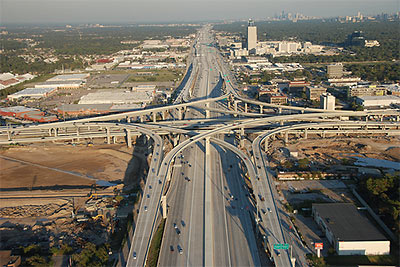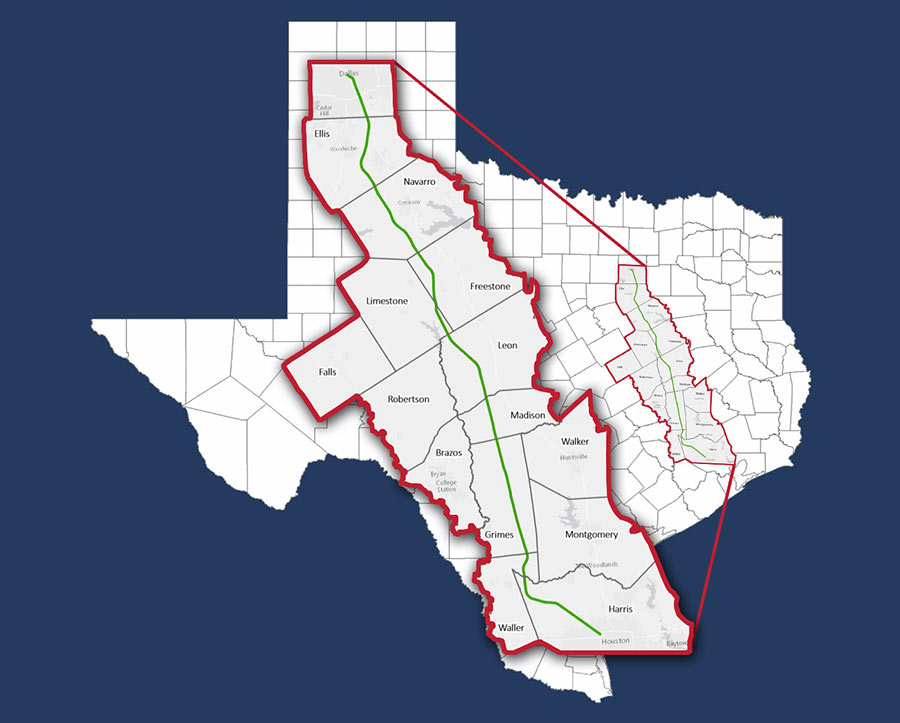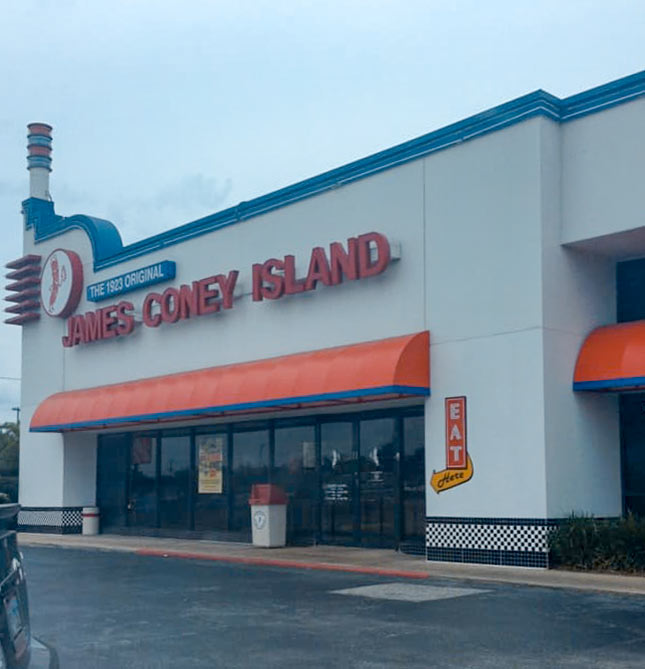
Let the Great Katy Freeway Lane Rush begin! More than 5 years and $2.8 billion in the making, West Houston’s new 18-car-wide and rail-free Main Street is at last officially complete — and open for more traffic than ever! The tollway on the four inside “managed lanes” won’t be instituted until April. Until then, those lanes are meant for cars with more than one passenger.
- The Katy’s Grand Re-Opening [Off the Kuff]
- New Katy Fwy. HOV lanes open to drivers [11 News]
- Katy Freeway expansion declared done [Houston Chronicle]
- How to navigate the new Katy [Houston Chronicle]
- Interested in riding the Katy Freeway Managed Lanes? Here’s what you need to know. [HCTRA]
- Katy Freeway Finished As Of Tomorrow [Hair Balls]
- Previously in Swamplot: Katy Freeway Construction: End in Sight
Photo of I-10 West and Sam Houston Tollway interchange: Flickr user Rustypicstx





It marks a great day!
The schedule was 10-13 years to reconstruct it.
It’s schedule was changed to 6 years and they still built in less time through innovative construction staging.
The final cost came in under budget too.
The final project planted over 75,000 trees and built large detention facilities to offset increased storm runoff.
This project is setting a new standard for speedy expressway reconstruction.
It also provides increased reliable commuting with connections to future rail (updtown light rail).
From kjb434:
The schedule was 10-13 years to reconstruct it.
————————
Instead, they finished it just in time for John Culberson’s tight Congressional race!
But back in 2003, when they started, they said it would take 5 years, so I don’t know where they 10-13 year schedule you are speaking of comes from. (http://www.click2houston.com/automotive/2315519/detail.html)
—————————————–
The final cost came in under budget too.
——————————————
Wha-? I thought the initial budget was $1.4 billion (same source).
—————————————-
The final project planted over 75,000 trees and built large detention facilities to offset increased storm runoff.
—————————————
And how many houses were torn down in Spring Valley and Houston for this? (And what is the NPV of the lost property taxes from those houses?)
—————————————
It also provides increased reliable commuting with connections to future rail (updtown light rail).
————————————–
This is the biggest headscratcher. Connections to what rail? They could have puit rail in the freeway–that’s been talked about since the 80s, and in widening the freeway, they did in fact pave over an old rail right-of-way. But all I see are 18 lanes of rail-free concrete.
“But back in 2003, when they started, they said it would take 5 years, so I don’t know where they 10-13 year schedule you are speaking of comes from.”
Using traditional construction sequencing, a road construction project of this magnitude would ordinarily take 10 to 12 years. In order to complete the task in six years, the contractors are working 24 hours a day. (TxDOT, Texas Contractor Magazine, Governor Perry’s Press Release)
“Wha-? I thought the initial budget was $1.4 billion (same source).”
http://www.offthekuff.com/mt/archives/011121.html
Provides a good summary. There is a big difference from planning costs, construction costs, and total project costs. TxDOT revised it’s cost before contract letting to adjust for inflation in labor and materials cost. No contract cost more than it was let for which means it came in under budget. Massive add services didn’t need to occur. Also, it is crazy to thing that a construction cost estimate made 6 years prior the start of any construction would be valid. Just because a news story state the price at early planning stages and contrasts it to the final doesn’t mean it’s a valid association. Also, the estimated $1.4 billion in construction costs only went up to $1.7 billion. In large scale project terms, that is a great result. Just talk to the guys up in Boston about busting a budget. The biggest cost increase had little to do with actual construction, but more to do with property values. Right of Way acquisition cost shot up with the real estate market taking off raising the initial numbers.
“And how many houses were torn down in Spring Valley and Houston for this? (And what is the NPV of the lost property taxes from those houses?)”
Read the FEIS and DEIS on the Katyfreeway.org website. It details all this and this was made available to the public for comment before any federal record of decision was made. Economically the freeway has triggered massive commercial growth (property value) along the corridor. The tax value lost to the project has been more than offset. Also, properties that had to be purchased but are not part of the construction site, have been returned to natural conditions such as in Spring Valley. This acreage will not be developed on and remain as green space. Also, it’s misleading to say they lost property, they were compensated at market value which equal to or more than what they would get in today’s market. These people made out pretty good getting their property bought at a real estate high versus a low….
“This is the biggest headscratcher. Connections to what rail? They could have puit rail in the freeway–that’s been talked about since the 80s, and in widening the freeway, they did in fact pave over an old rail right-of-way. But all I see are 18 lanes of rail-free concrete.”
How much reading and research have you done? Is all your information from places like TV news and the newspaper which woefully mis-reports and leaves out valuable information? A critical component to the Katy Freeway project was the connection to METRO’s Northwest Transit Center. The Northwest Transit Center will be the part of the northern terminus of the Uptown light rail line. The light rail line will also connect to where the current Northwest Mall is located where a proposed commuter rail connection of the 290 corridor will be made. As for rail in the corridor, please read the FEIS, DEIS, and the Katy Freeway FAQs which answer this question in detail. It was looked at. It was studied in detail. This was popular question at the public meetings. And a little secret from my transportation background in Civil Engineering, rail will never reduce traffic congestion and should only be used as an additional option to road expansion. The reality is that the HOV/Toll Road combo in the middle will be able to move many more commuters at a far less cost than rail could ever achieve. The H-GAC which aggregates transportation planning in the 8 county region to ensure consistent planning across all transportation providers studies this in detail also. A commuter rail option would not have reduce the need for a freeway of this size.
Great. Now we get to pay tolls to drive on the Katy Freeway for the next 20 years (or forever) because John Culberson couldn’t do his job and cut through some red tape even with a Bush in the freakin’ White House.
The ONLY reason the HCTRA is involved in this deal is besause their bond issuing capasity allowed us to start this project two years earlier than if we had let Uncle Sam pay for it.
I’m glad the project is done now instead of 2011, but if Cluberson would have done his job and got the Feds to pay for all of this, we’d all be riding free of charge. Instead we pay tolls while our income taxes get used on the Big Dig road project in Boston.
The only thing worse is Perry’s plan to sell our highways to Spain instead of having Uncle Sam pay for them like every ohter state does. At least that one is on hold for now.
Sarah Palin frightens me as a possible VP, but at least she knows how to go to DC and return home with money. That’s more than I can say for the Bozos we elect around here.